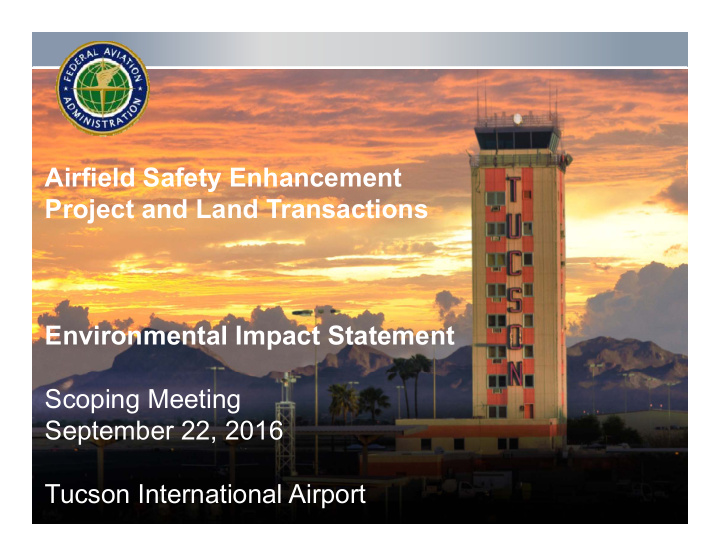



Airfield Safety Enhancement Project and Land Transactions Environmental Impact Statement Scoping Meeting September 22, 2016 Tucson International Airport
AGENDA Purpose and Need Sponsor’s Proposed Action Range of Alternatives EIS Purpose and Process Environmental Impact Categories Schedule Contact
3
Sponsor’s Purpose and Need The need to enhance the safety of the airfield and eliminate existing “hot spots”. The need to prevent aircraft from crossing directly between two parallel runways as recommended in FAA Engineering Brief 75, Incorporation of Runway Incursion Prevention into Taxiway and Apron Design. The need to maintain operational capabilities when there is a temporary closure of Runway 11L/29R. The need to develop currently under-utilized land that is compatible with FAA airspace restrictions and design standards.
Federal Purpose and Need FAA Purpose and Need The need to operate TUS in the safest manner possible pursuant to 49 U.S.C. 47101(1), and reduce the potential risk of runway incursions to the extent practicable. USAF Purpose and Need The need to maintain United States Air Force (USAF) Plant 44 operational capabilities. National Guard Bureau Purpose and Need The need to maintain National Guard Bureau (NGB) safety standards and operational capabilities.
Sponsor’s Proposed Action Proposed Relocation of Runway 11R/29L Relocation and reconstruction of Runway 11R/29L as an 11,000 foot long, 150 foot wide runway Displace Runway 11L Arrivals Threshold Proposed New Airfield Improvements Construct New Center Parallel Taxiway Construct New Outboard Parallel Taxiway Construct Bypass Taxiway Construct Supporting Connector Taxiways Construct Detention Basins
Sponsor’s Proposed Action Associated Actions Land Transactions/Conveyance of Parcel F from USAF to TAA, Parcel G from TAA ultimately to USAF, and Parcel H from TAA ultimately to USAF Demolition of twelve USAF “A” Magazines Construction of replacement “A” Magazines elsewhere on USAF Plant 44 Construction of Air National Guard Munitions Storage Area
8
Range of Alternatives No Action Alternative Development Alternatives Sponsor’s Proposed Action Other Airfield Development Alternatives at TUS Use of Other Existing Airports Use of Other Modes of Transportation
EIS Purpose and Process Role of Federal Aviation Administration (FAA) Serves as the Lead Federal Agency on the EIS. To ensure actions meet the National Environmental Policy Act (NEPA) goals and policies. Directs the work performed by the Consultant. Role of the United States Air Force (USAF) and National Guard Bureau (NGB) Cooperating agency for the EIS. Involved as alternative sites may occur on USAF owned land. Role of Airport Sponsor / Tucson Airport Authority (TAA) Assist the FAA in acquiring data. Assist with public involvement and outreach components of the EIS.
EIS Purpose and Process Role of the Regulatory Agencies Help identify potentially significant environmental impacts Review and comment on EIS finding Issue environmental permits where applicable Review proposed mitigation strategies where applicable Ensure compliance with local, state, and Federal environmental regulations
EIS Process W e Are Publish blish N Noti tice o of Here Intent to Int to Prepare Prepare RECORD RECORD 30-Da 30- Day EIS EI OF OF Waiting Perio Wait Period DE DECISION CISION Conduct nduct Public blic & & Agency S Scopin ing Publish blish F Final EIS nal EIS Notic tice o e of Availabi ilabilit lity y Prepar are Dr e Draft E t EIS Prepar are e Final EI Fin EIS Publish blish Notic tice o e of A Availabilit bility Conduct nduct 45-Da 45- Day Public blic H Hearing ing Commen Comment Period Period Beg Begins
Environmental Impact Categories Air Quality Biological Resources (Fish, Wildlife, and Plants) Climate Coastal Resources Department of Transportation Act, Section 4(f) Farmlands Hazardous Materials, Solid Waste, and Pollution Prevention Historical, Architectural, Archeological, and Cultural Resources Land Use Natural Resources and Energy Supply Noise and Compatible Land Use Socioeconomics, Environmental Justice, and Children’s Environmental Health and Safety Risks Visual Effects (including light emissions) Water Resources (including wetlands, floodplains, surface waters, groundwater, and wild and scenic rivers) Cumulative Impacts Sources: FAA Order 1050.1F, Environmental Impacts: Policies and Procedures; FAA Order 5050.4B, National Environmental Policy Act (NEPA) Implementing Instructions for Airport Actions; Title 32, Code of Federal Regulations (CFR), Part 989 Environmental Impact Analysis Process (EIAP)
14
Schedule Notice of Intent – August 19, 2016 • Agency and Public Scoping – September 22, 2016 • FAA prepares Draft EIS document – Fall/ Winter 2017 • Public Hearing and Workshop – Spring 2018 • Final EIS – Fall 2018 • FAA issues its finding in a • Record of Decision (ROD) – Fall 2018
Contacts FAA Project Manager Mr. David B. Kessler, M.A., AICP Federal Aviation Administration Western-Pacific Region-Airports Division AWP-610.1 P.O. Box 92007 Los Angeles, CA 90009-2007 310-725-3615
Recommend
More recommend